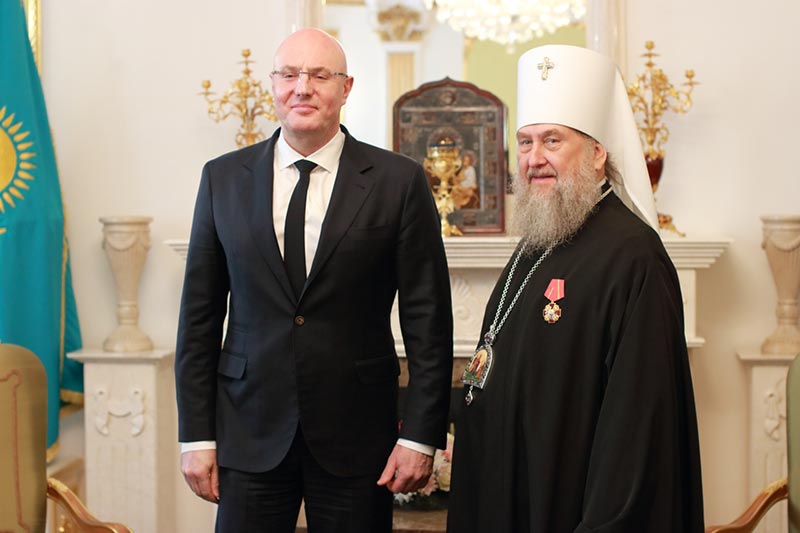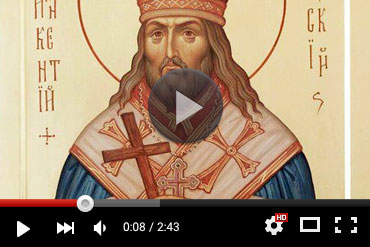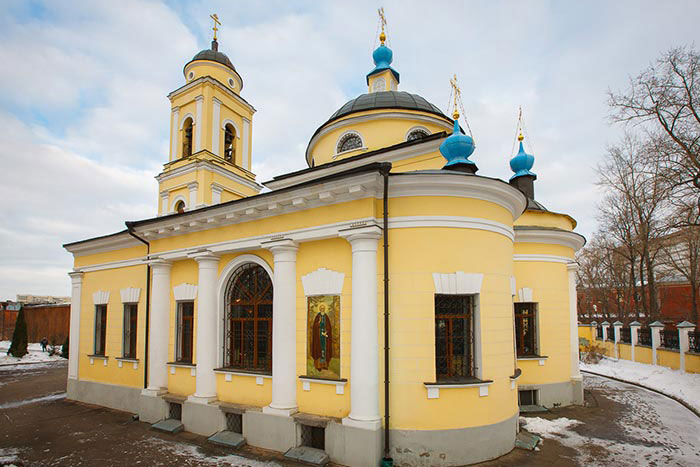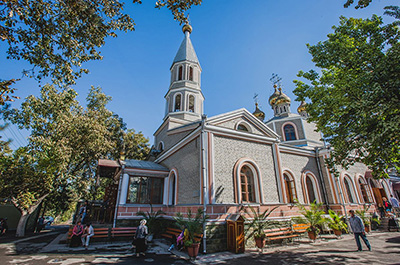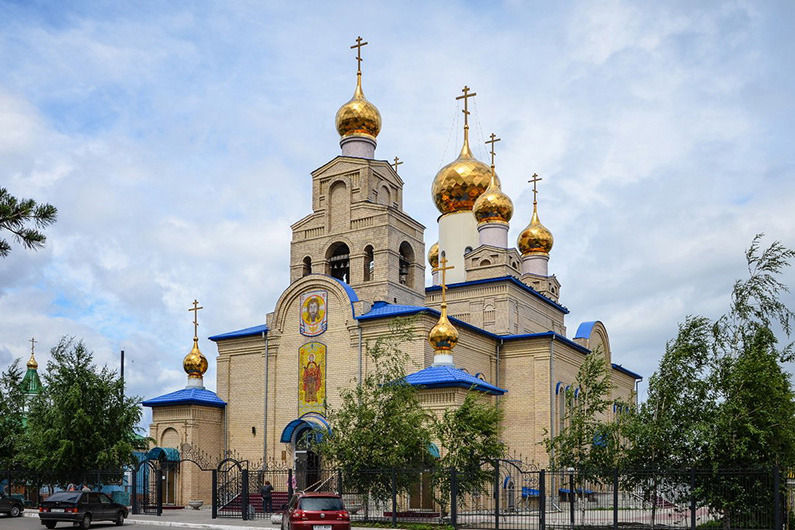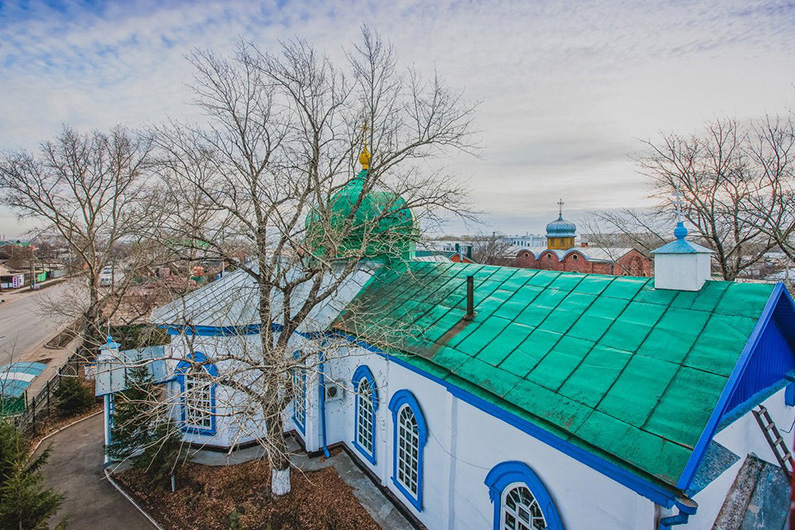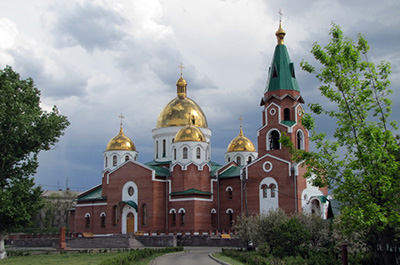
At the end of Bright Week, Metropolitan Alexander celebrated the Liturgy in the Cathedral of St. Michael the Archangel in the city of Uralsk
- 26.04.2025, 15:48
- Новости на английском языке

April 26, 2025 – Saturday of Bright Week.
Metropolitan Alexander of Astana and Kazakhstan celebrated the Divine Liturgy with the Easter rite in the Cathedral of St. Michael the Archangel in the city of Uralsk.
The Primate of the Orthodox Church of Kazakhstan was assisted by: Bishop Nikolai of Salavat and Kumertau (Bashkortostan Metropolitanate); Bishop Ignatius of Aktobe and Kyzylorda; Vicar of the Astana Diocese Bishop Veniamin of Talgar; Bishop Vianor of Uralsk and Atyrau; Rector of the Almaty Church in Honor of the Icon of the Mother of God "Joy of All Who Sorrow" Archpriest Evgeny Vorobyov; Rector of the St. Michael the Archangel Cathedral in Uralsk, Archimandrite Feodosiy (Kuryanov); Cleric of the Pokrovsky Convent in Uralsk, Archimandrite Dionysius (Kozulev); Rector of the Church of St. Nicholas the Wonderworker in the capital of Western Kazakhstan, Hegumen Ilya (Danileiko); Rector of the Cathedral of Christ the Savior in Uralsk, Archpriest Anatoly Robu; Head of the Information Department of the Ural Diocese, Hegumen Dorofey (Dilmanaev); Head of the Administrative Secretariat of the Head of the Metropolitan District, Priest Georgy Sidorov; Clergy of the Ural Diocese and Clergy of the Orenburg Metropolitanate; Head of the Metropolitan's Protocol Service, Protodeacon Roman Golovin; Protodeacon Vladimir Syrovatsky; Deacon Rustik Yakubov.
The liturgical hymns were performed by the bishop's choir under the direction of choirmaster L. Bondareva.
The following prayed at the Liturgy: the abbess of the Pokrovsky Monastery, Abbess Varvara (Morozova) with the nuns of the monastery; parishioners of churches in the city of Uralsk, pilgrims from the surrounding settlements of Western Kazakhstan, and representatives of the Cossacks.
The following were present at the service: Apostolic Administrator Monsignor Peter Sakmar; representatives of state authorities.
Following the communion verse, Priest Georgy Sidorov read out the Easter message of Metropolitan Alexander of Astana and Kazakhstan.
At the end of the Liturgy, the glorification of the Bright Resurrection of Christ took place, after which the hierarch broke the Holy Artos – the Easter consecrated bread and blessed it for the faithful to eat, “so that all who partake of it may be deemed worthy of physical and spiritual blessing and health.”
The head of the Metropolitan District cordially thanked the hierarchs, clergy and all participants in the service for their common prayer and congratulated those gathered on the Easter celebrations.
Having exchanged Easter greetings with the clergy and the faithful, the Metropolitan delivered a sermon.
The Divine Liturgy in the Archangel Michael Cathedral preceded the funeral service for the newly departed Archbishop Anthony (Moskolenko), who departed to the Lord on April 23. In the center of the church, the coffin with the body of the deceased hierarch was placed, covered in the ancient tradition with an archpastoral purple mantle. Parishioners of the cathedral and believers from the cities and villages of Western Kazakhstan gathered to perform a funeral prayer and say goodbye to the deceased Archbishop Anthony. Special funeral prayers were offered for the newly departed Bishop Archbishop at the Liturgy.
"Artos in Greek means leavened bread. This word refers to a special bread consecrated for the feast of Holy Easter. Artos occupied the most prominent place in our churches throughout the entire Bright Week, along with the image of the Resurrection of Christ, and was carried around the church in a religious procession. Today, at the end of Easter Week, it is broken into pieces and distributed to all believers. The use of artos dates back to apostolic times. We read in the Gospel that on the fortieth day after His Resurrection from the dead, the Lord Jesus Christ ascended to Heaven. The disciples and followers of Christ found consolation in prayerful remembrance of the Lord. Gathering for common prayer, they remembered the Last Supper, partook of the Body and Blood of Christ, and ate. They left a special place at such prayer meetings and meals for the Savior. In this place, as a sign of the real presence of the Lord among those who believed in Him, the apostles placed bread. The Artos reminded all participants in the service of the words of the Lord, in which He called Himself the Heavenly Bread that came down from Heaven. Imitating the apostles, the Church established the placing of the Artos in the church on the feast of the Resurrection of Christ, as a visible expression of the fact that the Savior who suffered for us became the true Bread of life for us and is inseparably with us. In the prayer for the blessing of this Easter bread, we asked the Lord to make all who partake of the Artos participants in the heavenly blessing and to remove every illness and disease from us by His power, granting health to all. Prayerful petitions for the granting of a blessing and spiritual and physical health were also offered up when it was broken. Let us carefully preserve this sacred bread in our homes and partake of it with reverence and prayer to Christ the Life-Giver, who was crucified for our sake and resurrected on the third day." From the sermon of Metropolitan Alexander.


